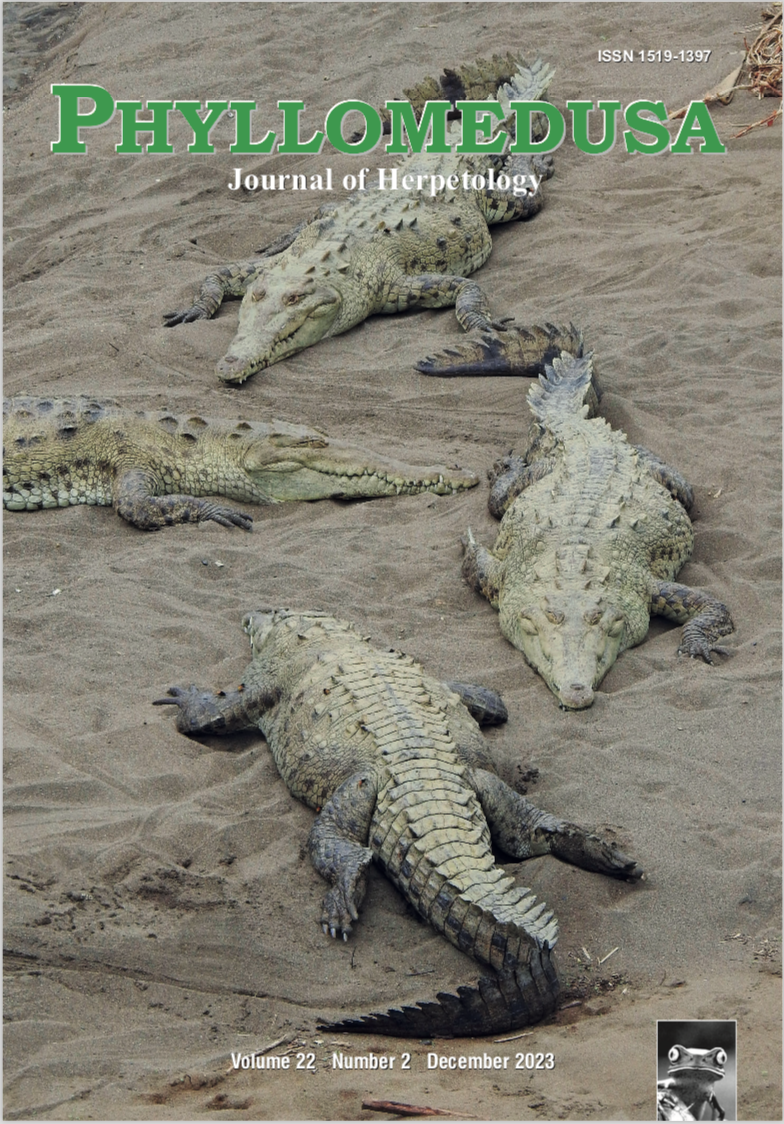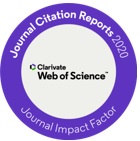Ecologia reprodutiva e história natural de Kinosternon herrerai (Testudines: Kinosternidae) no centro de sua distribuição
DOI:
https://doi.org/10.11606/issn.2316-9079.v22i2p171-179Palavras-chave:
Hidalgo, Reprodução, Tamanho da ninhada, Tartarugas-de-lama, Taxa de movimentoResumo
O México abriga 10 espécies endêmicas de tartarugas-de-lama do gênero Kinosternon, mas faltam informações sobre a história natural da maioria delas. Aqui, descrevemos algumas generalidades da ecologia reprodutiva e da história natural de uma população de Hidalgo da tartaruga-de-lama-de-herrera, K. herrerai, endêmica do México. As fêmeas e os machos eram semelhantes em termos de massa corporal e comprimento da carapaça. Além disso, as tartarugas maiores e mais pesadas se movimentavam mais do que as menores e mais leves. O tamanho da ninhada variou de um a seis ovos, com uma média de 3,4 ± 1,7, e a postura dos ovos ocorreu em temperaturas ambientais entre 15 e 21°C (x̅ = 18,6°C). O tempo total de nidificação (desde a seleção do local de nidificação até a ovipostura) durou cerca de 37 min, e o período de incubação foi de 75 dias in situ. Esses resultados aumentam nossa compreensão dos aspectos da história natural das espécies de Kinosternon, que são necessários para realizar ações de conservação para preservar todas as suas populações.
Downloads
Referências
Aguirre-León, G. and O. Aquino-Cruz. 2004. Hábitos alimentarios de Kinosternon herrerai Stejneger 1925 (Testudines: Kinosternidae) en el centro de Veracruz, México. Acta Zoológica Mexicana 20: 83–98.
Berlant, Z. S. and T. C. Stayton. 2017. Shell morphology in the Kinosternidae: functional and evolutionary patterns. Herpetologica 73: 30–42.
Berriozabal-Islas, C., A. Ramírez-Bautista, F. TorresÁngeles, J. F. Mota Rodrigues, R. Macip-Ríos, and P. Octavio-Aguilar. 2020. Climate change efects on turtles of the genus Kinosternon (Testudines: Kinosternidae): an assessment of habitat suitability and climate niche conservatism. Hydrobiologia 847: 4091–4110.
Berriozabal-Islas, C., A. Ramírez-Bautista, A. I. NavaJiménez, M. Rojas-Domínguez, E. Reyes-Grajales, and J. A. Loc-Barragán. 2023. Ni conocidas, ni carismáticas: estado de conservación de las tortugas del género Kinosternon (Spix, 1824) (Testudines: Kinosternidae) y sus factores de amenaza. Cuadernos de Biodiversidad 64: 6–18.
Berry. J. F. 1977. A model for plastron reduction in Kinosternine turtles. Abstracts, Annual Meeting, American Society of Ichthyologists and Herpetologists, University of Florida, Gainesville.
Berry, J. F. and R. Shine. 1980. Sexual size dimorphism and sexual selection in turtles (Order Testudines). Oecologia 44: 185–191.
Butterfeld, T., M. Olson, D. Beck, and R. Macíp-Ríos. 2020. Morphology, performance, and ecology of three sympatric turtles in a tropical dry forest. Copeia 108: 957–966.
Carr, J. L. and R. B. Mast. 1988. Natural history observations of Kinosternon herrerai (Testudines: Kinosternidae). Trianea 1:87–97.
Ceballos, C. P. and J. B. Iverson. 2014. Patterns of sexual size dimorphism in Chelonia: revisiting Kinosternidae. Biological Journal of the Linnean Society 111: 806–809.
De la Cruz-Merlo, M., E. Gaona-Murillo, and R. MacipRíos. 2022. Population ecology of the rough-footed mud turtles (Kinosternon hirtipes) in a high-altitude locality in Michoacán, México. Revista Latinoamericana de Herpetología 5: 112–122.
Ewert, M. A., C. R. Etchberger, and C. E. Nelson. 2004. Turtle sex-determining modes and TSD patterns, and some TSD pattern correlates. Pp. 21–89 in N. Valenzuela and V. A. Lance (eds.), Temperature-Dependent Sex Determination in Vertebrates. Washington. Smithsonian Books.
Global Biodiversity Information Facility (GBIF.org). 2023. GBIF Occurrence Download. Electronic Database accessible at https://doi.org/10.15468/dl.3398db. Captured on 15 October 2023.
Heston, L., P. Meylan, and J. M. Goessling. 2022 Life history consequences of miniaturization in turtles: evidencefrom the subfamily Kinosterninae (Testudines: Kinosternidae). Biological Journal of the Linnean Society 135: 558–568.
Iverson, J. B. 1985. Geographic variation in sexual dimorphism in the Mud turtle, Kinosternon hirtipes. Copeia 1985: 388-393.
Iverson, J. B. 1989. Natural history of the Alamos Mud Turtle Kinosternon alamosae (Kinosternidae). Southwestern Naturalist 34: 134–142.
Iverson, J. B. 1991a. Patterns of survivorship in turtles (order Testudines). Canadian Journal of Zoology 69: 385–391.
Iverson, J.B. 1991b. Life history and demography of the yellow mud turtle, Kinosternon favescens. Herpetologica 47: 373–395.
Iverson, J. B. 1991c. Phylogenetic hypotheses for the evolution of modern Kinosternine turtles. Herpetological Monographs 5: 1–27.
Iverson, J. B. 1999. Reproduction in the Mexican mud turtle Kinosternon integrum. Journal of Herpetology 33: 144–148.
Iverson, J. B. and E. R. Lewis. 2018. How to measure a turtle. Herpetological Review 49: 453–460.
Legler J. M. and R. C. Vogt (eds.). 2013. The Turtles of Mexico Land and Freshwater Forms. Berkeley. University of California Press. 402 pp.
Loc-Barragán, J. A., J. Reyes-Velasco, G. A. Woolrich-Piña, C. I. Grünwald, M. Venegas de Anaya, J. A. RangelMendoza, and M. A. López-Luna. 2020. A new species of mud turtle of genus Kinosternon (Testudines:Kinosternidae) from the Pacifc coastal plain of northwestern Mexico. Zootaxa 4885: 509–529.
López-Luna, M. A, F. G. Capul-Magaña, A. H. EscobedoGalván, A. J. González-Hernández, E. Centenero-Alcalá, J. A. Rangel-Mendoza, M. M. Ramírez-Ramírez, and E. Cazares-Hernández, E. 2018. A distinctive new species of mud turtle from Western Mexico. Chelonian Conservation and Biology 17: 2–13.
Macip-Ríos, R., M. L. Arias-Cisneros, X. Aguilar-Miguel, and G. Casas-Andreu. 2009. Population ecology and reproduction of the Mexican Mud Turtle (Kinosternon integrum) in Tonatico, Estado de México. Western North American Naturalist 69: 501–510.
Macip-Ríos, R., P. Brauer-Robleda, J. J. Zúñiga-Vega, and G. Casas-Andreu. 2011. Demography of two populations of the Mexican Mud Turtle (Kinosternon integrum) in central Mexico. Herpetological Journal 21: 235–245.
Macip-Ríos, R., R. Ontiveros, S. López-Alcaide, and G. Casas-Andreu. 2015. The conservation status of the freshwater and terrestrial turtles of Mexico: a critical review of biodiversity conservation strategies. Revista Mexicana de Biodiversidad 86: 1048–1057.
Macip-Ríos, R., R. N. Ontiveros, A.T. Sánchez-Léon, and G. Casas-Andreu. 2017. Evolution of reproductive efort in mud turtles (Kinosternidae): a role of environmental predictability. Evolutionary Ecology Research 18: 339–354.
Macip-Ríos, R., M. T. Jones, L. L. Willey, T. S. Akre, E. González-Akre, and L. Díaz-Gamboa. 2018. Population structure and natural history of Creaser’s mud turtle (Kinosternon creaseri) in central Yucatán. Herpetological Conservation and Biology 13: 366–372.
Parlin, A. F., J. P. Amaral, J. K. Dougherty, M. H. Stevens, and P. J. Schaefer. 2017. Thermoregulatory performance and habitat selection of the eastern box turtle (Terrapene carolina carolina). Conservation Physiology 5:1–15.
Pavón, N. P. and M. Mesa-Sánchez (eds.). 2009. Cambio Climático en el Estado de Hidalgo: Clasifcación y Tendencias Climáticas. Pachuca. Universidad Autónoma del Estado de Hidalgo. 168 pp.
Pough, H. F., R. M. Andrews, J. E. Caldwell, M. L. Crump, A. H. Savitzky, and K. D. Wells 2001. Herpetology. 2nd Edition. Upper Saddle River. Pearson Prentice Hall. 612 pp.
Pritchard, P. C. H. and P. Trebbau (eds.). 1984. The Turtles of Venezuela. Ithaca. Society for the Study of Amphibians and Reptiles. 404 pp.
Ramírez-Bautista, A., L. A. Torres-Hernández, R. CruzElizalde, C. Berriozabal-Islas, U. Hernández-Salinas, L. D. Wilson, J. D. Johnson, L. W. Porras, C. J. BalderasValdivia, A. J. X. González-Hernández, and V. MataSilva. 2023. An updated list of the Mexican herpetofauna: with a summary of historical and contemporary studies. ZooKeys 1166: 287–306.
Reyes-Grajales, E., R. Macip-Ríos, J. B. Iverson, and W. A. Matamoros. 2021. Population ecology and morphology of the Central Chiapas Mud Turtle (Kinosternon abaxillare). Chelonian Conservation and Biology 20: 18–26.
Rosales-Martínez, C. S., C. D. Bello-Sánchez, M. A. LópezLuna, A. H. Escobedo-Gálvan, and F. G. Cupul-Magaña. 2022. First observations on courtship and nesting behavior of Kinosternon vogti (Testudines:Kinosternidae). Cuadernos de Herpetología 36: 95–99.
Stearns, S. C (ed.). 1992. The Evolution of Life Histories. Oxford. Oxford University Press. 249 pp.
SEMARNAT (Secretaría de Medio Ambiente y Recursos Naturales). 2010. Norma Ofcial Mexicana NOM-059, Protección ambiental de especies nativas de México de fora y fauna silvestres-Categorías de riesgo y especifcaciones para su inclusión, exclusión o cambioLista de especies en riesgo. Diario Ofcial de la Federación, Ciudad de México, México.
TTWG (Rhodin, A. G. J., J. B. Iverson, R. Bour, U. Fritz, A. Georges, H. B. Shafer, and P. P. van Dijk). 2021. Turtles of the world: annotated checklist and atlas of taxonomy, synonymy, distribution, and conservation status. 9th Edition. Chelonian Research Monographs 7: 1–472.
van Dijk, P. P., G. Hammerson, P. Lavin, and F. MendozaQuijano. 2007. Kinosternon herrerai. The IUCN Red List of Threatened Species. Electronic Database accessible at http://dx.doi.org/10.2305/IUCN.UK.2007.RLTS.T63669A12705142.en. Captured on 02 April 2023.
Vázquez-Gómez, A. G., M. Harfush, and R. Macip-Ríos. 2015. Notes on the reproductive ecology of the Oaxaca mud turtle (Kinosternon oaxacae) in the vicinity of Mazunte, Mexico. Acta Herpetologica 10: 121–124.
Vázquez-Gómez, A. G., M. Harfush, and R. Macip-Ríos. 2016. Observations on population ecology and abundance of the micro-endemic Oaxaca Mud Turtle (Kinosternon oaxacae). Herpetological Conservation and Biology 11: 265–271.
Downloads
Publicado
Edição
Seção
Licença
Copyright (c) 2023 ESALQ-USP

Este trabalho está licenciado sob uma licença Creative Commons Attribution-NonCommercial-NoDerivatives 4.0 International License.
All material originally published in Phyllomedusa belongs to Escola Superior de Agricultura Luiz de Queiroz - Universidade de São Paulo. All contents are under a license of Creative Commons BY-NC-ND.


 Impact Factor: 0.383
Impact Factor: 0.383  CiteScore: 0.7
CiteScore: 0.7